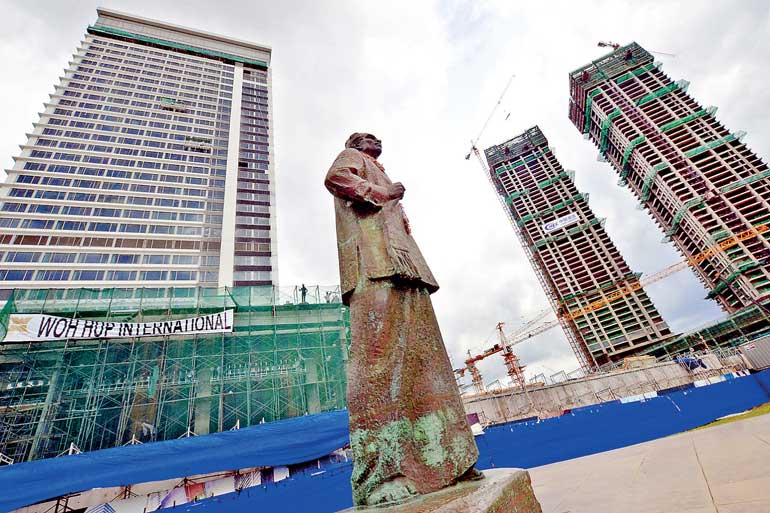Friday Dec 13, 2024
Friday Dec 13, 2024
Friday, 3 March 2017 00:00 - - {{hitsCtrl.values.hits}}
 Ongoing construction in Colombo. Despite the challenging environment, growth in developing Asia as a whole is still robust. ADB forecasts regional GDP will grow by 5.7% this year. Infrastructure development will need to keep up with the pace of future economic expansion – Pic by Shehan Gunasekara
Ongoing construction in Colombo. Despite the challenging environment, growth in developing Asia as a whole is still robust. ADB forecasts regional GDP will grow by 5.7% this year. Infrastructure development will need to keep up with the pace of future economic expansion – Pic by Shehan Gunasekara
By Abdul Abiad
We’re overdue for an update of Asia’s estimated infrastructure investment needs. ADB last estimated infrastructure investment needs for Asia and the Pacific in 2009. In a joint study with the ADB Institute, we identified the need for about $8 trillion worth of investment from 2010 to 2020, roughly $750 billion a year.
We’re now more than halfway through that timeline. Those estimates now speak more about the past than the future. Eight years to revisit these estimates is a long time, but the past eight years in particular have been tumultuous. Three big changes make it valuable to take a fresh look at Asia’s infrastructure investment needs.
First is the new global and regional economic environment. In 2009, the world was still in the midst of the global financial crisis, and there was much uncertainty. In 2017, the picture is clearer: growth in many advanced economies is lacklustre, particularly in Europe and Japan; some large emerging markets like Brazil and Russia are struggling, in part due to the fall in commodity prices; and growth has moderated in the People’s Republic of China (PRC).
Amid this challenging environment, growth in developing Asia as a whole is still robust. ADB forecasts regional GDP will grow by 5.7% this year. Infrastructure development will need to keep up with the pace of future economic expansion.
Second is our deeper understanding and appreciation of climate change and its impacts. This is what led 195 countries to sign on to the 2015 Paris Agreement and pledge to meet nationally determined contributions to help keep the increase in global temperatures below 2°C.
Climate change matters for infrastructure in a couple of ways. There needs to be a shift toward “green” sources of energy to help countries meet their emissions reduction targets. And infrastructure needs to be “climate-proofed,” or made more resilient to changes such as rising sea levels and more extreme weather events.
The third big change is the rise of new initiatives and actors in Asia’s infrastructure development landscape. The PRC rolled out its Belt and Road Initiative in 2013 to support regional infrastructure. Two years later Japan launched its Partnership for Quality Infrastructure, which aims to provide $110 billion for regional infrastructure development by 2020. The Asian Infrastructure Investment Bank (AIIB) began operations in 2016 with $100 billion in capital, and extended $1.7 billion in loans in its first year of operations. Existing players are ramping up operations—ADB’s lending rose 17% last year to $31.5 billion, including cofinancing.
While some people like to focus on the competition among various actors and initiatives, the reality is that infrastructure needs far outstrip the capacity of any one program or institution. The needs are massive and there is enough space for everyone. At present, the supply of feasible projects is as much a constraint as the availability of finance. Institutions like ADB and AIIB can help here as well by providing technical assistance to help governments with the challenging work of preparing feasible projects for investment.
In light of these changes, ADB studied the region’s investment requirements and published its findings in a new report, Meeting Asia’s Infrastructure Needs.
The report incorporates the latest views on Asia’s growth trajectory. It accounts for the impact that climate change will have on the region’s infrastructure needs, and identifies how development partners can support countries to ensure infrastructure remains an enabler of growth and not a limitation.
The updated estimates are eye-popping. When climate change and new growth projections are factored in, developing Asia will need about $26 trillion in infrastructure investment between 2016 and 2030. That amounts to $1.7 trillion a year, or more than twice our 2009 forecasts.
The increase is due to higher GDP estimates, the inclusion of climate change-related investments, the use of 2015 prices instead of 2008 prices, and a wider country pool. But the really important point is that the projected needs are almost twice the roughly $900 billion a year that the region currently invests in infrastructure.
The public sector, which still accounts for most infrastructure investment in the region, has the potential to finance just over half of the needed investment. This implies that private sector involvement in infrastructure will have to increase big-time—probably three or four times current levels. This will require deeper capital markets, a greater supply of financially viable projects, and improvements in the legal and regulatory environment in many countries.
Asian economies face a large task to deliver the infrastructure they will need to sustain growth and deal with climate change. Let’s get started.
(The writer is Advisor, Economic Research and Regional Cooperation Department, ADB)